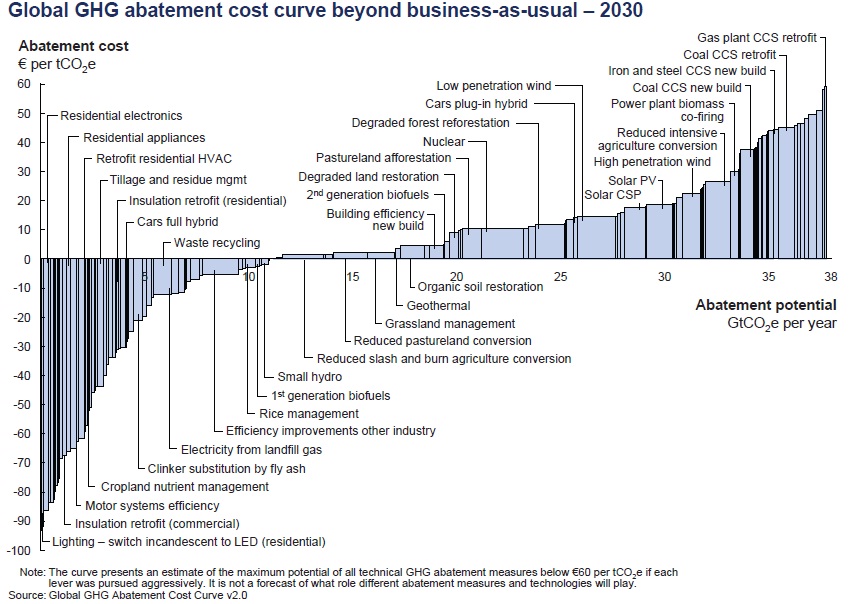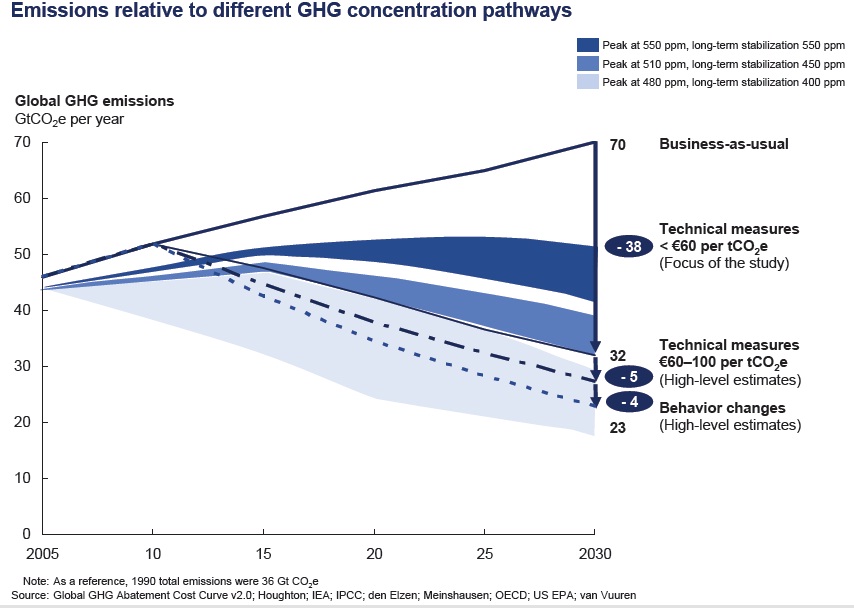In my last entry, I pointed to the argument that the committed fund for climate change mitigation and adaptation is nowhere near what is needed to meet the target of limiting temperature rise to 20C by 2030. Within the past few days of negotiation here at COP15, Africa Union has lowered its requested financial support to make an agreement more feasible. Today Hillary Clinton pledged an amount of US$100 billion from developed world for climate finance by 2020, which is at the low end of what is expected. Both sides are moving toward compromising on a lower finance level. After COP15, it is almost certain that funding for climate change mitigation and adaptation will not increase that much. With limited money, what sectors and areas should we focus on to achieve the most impact?
At least three climate finance side events that I have been to here cited the McKinsey Global GHG Cost Curve as a reference for quantifying the cost of limiting climate change. This 192 page report was published by McKinsey, a consultancy, in 2009 after extensive evaluation of 200 greenhouse gas abatement opportunities in 10 sectors and 21 world regions. Using a consistent formula, the report quantified the cost and impact of each abatement method. Despite many assumptions made by the report to arrive at a high level of consistency, it added tremendous value by analyzing methods using concrete quantification. I think this is extremely helpful amidst all the talk about different ways to limit climate change at COP15 such as efficient buildings, hybrid cars, efficient home appliances, solar panels, geothermal, and even vegetarian diet. Each method has its merits. In an ideal world maybe all of them should be implemented. Yet, with limited finance as we have seen in reality, prioritizing methods with the most impact at the lowest cost would be preferable.
(Wider bars indicate bigger impact. Higher bars indicate higher cost)
According to the McKinsey cost curve, methods with negative cost (resulting in saving) include LED lighting, insulation retrofit, cars full hybrid, waste recycling and motor system efficiency among others. High cost methods are gas plant CCS retrofit, power plant biomass co-firing, nuclear energy, etc. Those are all technology-based abatement methods.
Compared to technical measures mentioned above, behavior changes have much lower impact, with a full potential of reducing about 5 gigaton of CO2 equivalent per year by 2030. McKinsey, however, made it clear that this impact level was arrived at under the assumption that all technical measures would be implemented before any behavior changes. In reality, if technology is not pursued to its full potential, behavior changes may have bigger impact. Nevertheless, based on this report, behavior changes have much lower abatement potential than technical measures.
My last comments: first, this report is very popular among both NGOs and businesses at COP15 and second, strategy consultancies such as McKinsey often set business trends.
Tags: adaptation, Climate Finance, Luan Nguyen, McKinsey Abatement Cost Curve
I wrote a blog a few weeks ago about transition towns, so I wanted to follow up on the coverage of Transition here in Copenhagen. Transition initiatives are indeed being discussed in this grand city, however, not in the Bella Center, but at the Klimaforum. I met several people who are beginning or are already involved in transition movements here, both within the city of Copenhagen and beyond.
On Monday, although I wasn’t sure what I was getting myself into, I attended an event hosted by Trapese Popular Education Collective called Climate Change and the Politics of Transition. The premise of this session was based on a Trapese Collective publication called ‘The Rocky Road to transition: The Transition Towns Movement and what it means for social change,’ which offers an analysis and critique of the Transition Movement. Although they support the movement, one of their strongest criticisms or concerns with the movement is that it avoids confronting the “enemy.” In other words, the authors feel that in order to create real social change we need to clearly identify what is not working, what we want to move away from and confront it. Say no to it. Fight it. They believe that because the Transition Movement does not emphasis this sort of activism, it tries to disconnected from politics.
This line of thinking was fascinating to me because this was never something that ever crossed my mind. To me, the strength of the transitions movement is that it appeals to everyone. Its strength is that it is an inclusive movement. It focuses on we, not us and them. At this juncture of time, it’s absolutely necessary that we focus on our commonalities and our mutual involvement in this global problem, not who is wrong or right. The activism for which Transition advocates is that of synergy; connecting, building and creating. This type of activism inherently diverges from those systems that currently disserve us, but does not require pointing finger and blame. Personally I feel that much energy is wasted on activism that focuses on fighting instead of building. It was really interesting to be in a room full of people who did not feel the same way. Maybe they could see beyond the excitement I feel about the Transition Movement, or maybe they don’t truly understand Transition; it’s still not clear to me. I thought about peacing out, but I decided to stay. I’m glad I did, because the event was run in a very unique and helpful way. I’d like to share some of the uniqueness that I connected most deeply with.
Tags: adaptation, climate change, Danielle Hoffman, interconnectivity, klimaforum2009, Trapese Popular Education Collective
Low carbon economy represents the general trend, and cap and trade systemem is going to be a future international trade form which has a huge potential. For a long time, cap and trade system has been thriving in developed countries, especially in EU. In the current system, the whole process is mostly decided by the buyers, and the sellers can only follow the rule. However, most buyers are developed countries while sellers are developing countries. Developing countries started questioning the equity in this kind of single ruled system in which carbon might be resold in developing countries because of low prices.
Recently, Beijing Environmental Exchange in China has carried out a Panda Standard which monitors its emission cuts and more over, regulates provisions and creates a perfect market mechanism. China has the potential to be a big player in the future internaitonal carbon market, but other standards may not be suitable for China, and that was why China has developed its own system. China should develop its own standard so that it would not be restricted to participate using its full potential. The instauration of the Panda Standard satisfies the requests from Chinese industries and individuals. Even though the Panda Standard is only a voluntary reduction standard, it shows China’s incentives to tackle the problem and it sets China’s position in the international market. China has the most carbon resource and is the largest carbon emitter that it has to involve in the international carbon talks, but there are still problems existing even with the Panda Standard being carried out. In China, the actual carbon market is still not mature that it does not have a full and perfect system. Whether the standard will become effective highly depends on the policies and the development of the market.
Tags: China, Flexible Mechanisms

Various forms of contraceptive which should be made available to all women, especially those living in developoing and vulnerable countries.

Tags: adaptation, climate change, developing countries, population growth
We are all stakeholders of global climate change, albeit to varying degrees.
And, for the most part, this conference has been open to incorporating a host of different peoples. In addition to the official country delegates and party members, individuals and organizations from business and civil society have influenced the negotiations through their indirect participation. Side events, demonstrations, media outreach, and informative dialogues have provided a means by which these constituencies can work to make changes they so seek. And they have done so in unique and meaningful ways. People have walked to Copenhagen from Greece, protested peacefully, and fasted for days to urge action by representing those stricken by hunger due to climate change (some of us will be doing this for a day or two, as well). Clearly we have an interest and stake at what is being negotiated…
And yet our access as observers has been limited (only 8 passes Tues/Weds and perhaps only 1 Thurs/Friday compared to 17 last week). Further, we are required to have secondary badges in order to attend the official plenary sessions for the rest of the week due to “security concerns” stemming from planned demonstrations. Certain side events require separate tickets for entrance. What is even more frustrating is keeping track of which plenary meetings are postponed and when/where they will be resumed. While I understand that COP15 — with 119 heads of State attending by the end of this week — has been the largest yet, I hope a trend is not being developed. I hope (and for the most part believe), delegates both appreciate the work civil society is doing as well as understand our interest in actually hearing what is being discussed. This is my hope. On Thursday and Friday, however, I will most likely be looking on from a computer screen.

Turned away at the door of this mornings Plenary
Tags: civil society, COP15 Resources, transparency




Your Comments